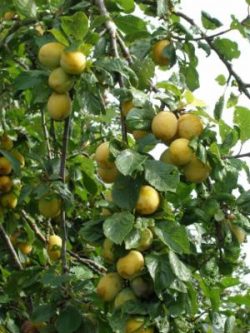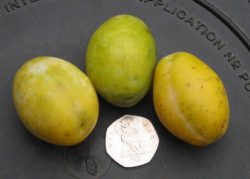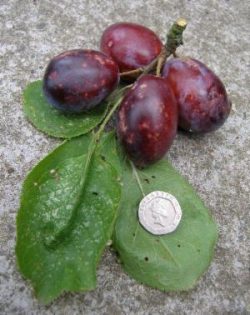In more recent times, certainly in the twentieth century, Worcestershire has become as famous for its plums as for any other fruit and the Vale of Evesham in particular is synonymous with plum growing. There are several varieties of plum that originated in the county.

Believed to have originated from a chance seedling found in Tyddersley wood near Pershore around 1871. It went on to become a widely propagated plum, much admired for its hardiness and disease resistance to both silver leaf and canker, and was extensively grown in the Vale of Evesham. In the late 1800s and early 1900s it was widely used as a rootstock onto which other plum varieties were grafted. A willingness to sucker also meant it was easily propagated by simply digging up a sucker and either growing it on as itself or using it as rootstock.
A willingness to sucker also meant it was easily propagated by simply digging up a sucker and either growing it on as itself or using it as rootstock.
The fruit is oval in shape with a very firm, dry, yellow flesh with an almost mealy texture and not much flavour. Hence it is very much a culinary or cooking plum to be picked in mid August and much suited to jam making, canning, pies and tarts. It went on to become the principal plum of the jam and canning industries around Evesham: sadly as the factories closed so demand for it died as it has a very short shelf life – when ripe it needs to be picked and processed within a day or two so without locally-based processing it ceased to be a commercial plum. Today suckers of it can be found in old orchards and hedgerows.

This variety is believed to have been a bud sport of the Pershore Yellow, or possibly a Pershore Yellow cross. It arose around 1877 from a Walter Martin of Drakes Broughton near Pershore and was originally named Martin’s Seedling, later becoming better known as Purple Pershore. It was first introduced commercially in the early 1900s.
Essentially a purple version of the Pershore Yellow, it is an excellent, heavy cropping culinary plum producing medium-sized reddish-purple fruit with a firm, slightly juicy flesh and a sub acid flavour. It is often lop-sided with a neck towards the stalk. The cooking and preserving qualities were soon recognised and it became widely grown in the Vale of Evesham along with the Yellow Pershore. It suffered a similar demise with the death of the canning and jam factories. Picking time is mid to late August
A new plum variety developed by a Mr Ged Witts in 2000 in Pershore, making it the first new plum variety in 100 years. It developed from a stone as a chance seedling on his allotment and produces plump, dark purple-skinned fruits with golden flesh in the early half of August. A very nice tasting dessert or culinary plum with one of the parents possibly being Early Prolific.
Another red sport of Pershore Yellow. It was discovered in about 1913 and introduced by Spiers of Evesham. The fruits have firm flesh with no dessert flavour but like its parent it cooks very well.
The one slight drawback of all the Pershore plums for the garden grower is that none of them are great dessert plums for eating fresh off the tree – the flesh appears on the dry side with little or no juice and the flavour is bland. Cooking, however, transforms them so making them all great culinary plums. The Pershore Yellow makes a wonderful golden yellow puree with a good flavour, ideal for jam or pie fillings. The Yellow is slightly sharper than the Purple and the Emblem.
The Pershore plums have many culinary uses including jam and chutneys, as an addition to cheese and sausages or as an ingredient in a range of great puddings. The drink Plum Jerkum is still made using various recipes.